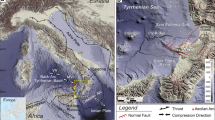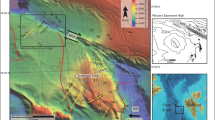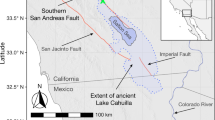Abstract
Temperature and fluid pressure conditions control rock deformation and mineralization on geological faults, and hence the distribution of earthquakes1. Typical intraplate continental crust has hydrostatic fluid pressure and a near-surface thermal gradient of 31 ± 15 degrees Celsius per kilometre2,3. At temperatures above 300–450 degrees Celsius, usually found at depths greater than 10–15 kilometres, the intra-crystalline plasticity of quartz and feldspar relieves stress by aseismic creep and earthquakes are infrequent. Hydrothermal conditions control the stability of mineral phases and hence frictional–mechanical processes associated with earthquake rupture cycles, but there are few temperature and fluid pressure data from active plate-bounding faults. Here we report results from a borehole drilled into the upper part of the Alpine Fault, which is late in its cycle of stress accumulation and expected to rupture in a magnitude 8 earthquake in the coming decades4,5. The borehole (depth 893 metres) revealed a pore fluid pressure gradient exceeding 9 ± 1 per cent above hydrostatic levels and an average geothermal gradient of 125 ± 55 degrees Celsius per kilometre within the hanging wall of the fault. These extreme hydrothermal conditions result from rapid fault movement, which transports rock and heat from depth, and topographically driven fluid movement that concentrates heat into valleys. Shear heating may occur within the fault but is not required to explain our observations. Our data and models show that highly anomalous fluid pressure and temperature gradients in the upper part of the seismogenic zone can be created by positive feedbacks between processes of fault slip, rock fracturing and alteration, and landscape development at plate-bounding faults.
This is a preview of subscription content, access via your institution
Access options
Access Nature and 54 other Nature Portfolio journals
Get Nature+, our best-value online-access subscription
$29.99 / 30 days
cancel any time
Subscribe to this journal
Receive 51 print issues and online access
$199.00 per year
only $3.90 per issue
Buy this article
- Purchase on SpringerLink
- Instant access to full article PDF
Prices may be subject to local taxes which are calculated during checkout



Similar content being viewed by others
References
Sibson, R. H. Fault zone models, heat flow, and the depth distribution of earthquakes in the continental crust of the United States. Bull. Seismol. Soc. Am. 72, 151–163 (1982)
Pollack, H. N., Hurter, S. J. & Johnson, J. R. Heat flow from the Earth’s interior: analysis of the global data set. Rev. Geophys. 31, 267–280 (1993)
Townend, J. & Zoback, M. D. How faulting keeps the crust strong. Geology 28, 399–402 (2000)
Cochran, U. et al. A plate boundary earthquake record from a wetland adjacent to the Alpine fault in New Zealand refines hazard estimates. Earth Planet. Sci. Lett. 464, 175–188 (2017)
Sutherland, R . et al. in A Continental Plate Boundary: Tectonics at South Island, New Zealand Geophysical Monograph Series (eds Okaya, D ., Stern, T. A . & Davey, F .) 235–251 (American Geophysical Union, 2007)
Byerlee, J. Friction of rocks. Pure Appl. Geophys. 116, 615–626 (1978)
Townend, J. & Zoback, M. D. Regional tectonic stress near the San Andreas fault in central and southern California. Geophys. Res. Lett. 31, L15S11 (2004)
Zoback, M. D ., Hickman, S. & Ellsworth, W. in Treatise on Geophysics (ed. Schubert, G. ) 649–674 (Elsevier, 2007)
Fulton, P. M., Saffer, D. M., Harris, R. N. & Bekins, B. A. Re-evaluation of heat flow data near Parkfield, CA: evidence for a weak San Andreas Fault. Geophys. Res. Lett. 31, L15S15 (2004)
Fulton, P. et al. Low coseismic friction on the Tohoku-Oki fault determined from temperature measurements. Science 342, 1214–1217 (2013)
Kano, Y. et al. Heat signature on the Chelungpu fault associated with the 1999 Chi-Chi, Taiwan earthquake. Geophys. Res. Lett. 33, L14306 (2006)
Li, H. et al. Long-term temperature records following the Mw 7.9 Wenchuan (China) earthquake are consistent with low friction. Geology 43, 163–166 (2015)
Di Toro, G. et al. Fault lubrication during earthquakes. Nature 471, 494–498 (2011)
Kanamori, H. & Brodsky, E. E. The physics of earthquakes. Rep. Prog. Phys. 67, 1429–1496 (2004)
Dieterich, J. H. Modeling of rock friction: 1. Experimental results and constitutive equations. J. Geophys. Res. Solid Earth 84, 2161–2168 (1979)
Carpenter, B., Marone, C. & Saffer, D. Weakness of the San Andreas Fault revealed by samples from the active fault zone. Nat. Geosci. 4, 251–254 (2011)
Wibberley, C. A. & Shimamoto, T. Earthquake slip weakening and asperities explained by thermal pressurization. Nature 436, 689–692 (2005)
Ohtani, T. et al. Fault rocks and past to recent fluid characteristics from the borehole survey of the Nojima fault ruptured in the 1995 Kobe earthquake, southwest Japan. J. Geophys. Res. Solid Earth 105, 16161–16171 (2000)
Ma, K. F. et al. Slip zone and energetics of a large earthquake from the Taiwan Chelungpu-fault Drilling Project. Nature 444, 473–476 (2006)
Williams, C. F., Grubb, F. V. & Galanis, S. P. Heat flow in the SAFOD pilot hole and implications for the strength of the San Andreas Fault. Geophys. Res. Lett. 31, L15S14 (2004)
Chester, F. M. et al. Structure and composition of the plate-boundary slip zone for the 2011 Tohoku-Oki earthquake. Science 342, 1208–1211 (2013)
Kitagawa, Y., Fujimori, K. & Koizumi, N. Temporal change in permeability of the Nojima fault zone by repeated water injection experiments. Tectonophysics 443, 183–192 (2007)
Morrow, C. A., Moore, D. E. & Lockner, D. A. Permeability reduction in granite under hydrothermal conditions. J. Geophys. Res. Solid Earth 106, 30551–30560 (2001)
Brenguier, F. et al. Postseismic relaxation along the San Andreas fault at Parkfield from continuous seismological observations. Science 321, 1478–1481 (2008)
Schaff, D. P. & Beroza, G. C. Coseismic and postseismic velocity changes measured by repeating earthquakes. J. Geophys. Res. Solid Earth 109, B10302 (2004)
Xue, L. et al. Continuous permeability measurements record healing inside the Wenchuan earthquake fault zone. Science 340, 1555–1559 (2013)
Norris, R. J. & Cooper, A. F. in A Continental Plate Boundary: Tectonics at South Island, New Zealand Geophysical Monograph Series (eds Okaya, D ., Stern, T. A . & Davey, F. ) 157–175 (American Geophysical Union, 2007)
Townend, J. Heat flow through the West Coast, South Island, New Zealand. N. Z. J. Geol. Geophys. 42, 21–31 (1999)
Sutherland, R. et al. Drilling reveals fluid control on architecture and rupture of the Alpine fault, New Zealand. Geology 40, 1143–1146 (2012)
Cox, S. et al. Changes in hot spring temperature and hydrogeology of the Alpine Fault hanging wall, New Zealand, induced by distal South Island earthquakes. Geofluids 15, 216–239 (2015)
Craw, D. Shallow-level metamorphic fluids in a high uplift rate metamorphic belt; Alpine schist, New Zealand. J. Metamorph. Geol. 6, 1–16 (1988)
Upton, P., Koons, P. O. & Chamberlain, C. P. Penetration of deformation-driven meteoric water into ductile rocks; isotopic and model observations from the Southern Alps, New Zealand. N. Z. J. Geol. Geophys. 38, 535–543 (1995)
Hartog, A. in Optical Fiber Sensor Technology 241–301 (Springer, 2000)
Sutherland, R. et al. Deep Fault Drilling Project (DFDP), Alpine Fault boreholes DFDP-2A and DFDP-2B technical completion report. GNS Sci. Rep. 2015, 1–269 (2015)
Upton, P. & Koons, P. O. in A Continental Plate Boundary: Tectonics at South Island, New Zealand Vol. 175 (eds Okaya, D., Stern, T. A. & Davey, F. ) 253–270 (American Geophysical Union, 2007)
Sutherland, R . et al. Deep Fault Drilling Project DFDP-1 and -2. Operational Datasets version 1, http://doi.org/10.5880/ICDP.5052.001 (GFZ Data Services, 2017)
Acknowledgements
We thank the Friend family for land access and the Westland community for support; Schlumberger for assistance with optical fibre technology; A. Benson, R. Conze, R. Marx, B. Pooley, A. Pyne and S. Yeo for engineering and site support; the CNRS University of Montpellier wireline logging group of P. Pezard, G. Henry, O. Nitsch and J. Paris; Arnold Contracting; Eco Drilling; and Webster Drilling. Funding was provided by the International Continental Scientific Drilling Program (ICDP), the NZ Marsden Fund, GNS Science, Victoria University of Wellington, University of Otago, the NZ Ministry for Business Innovation and Employment, NERC grants NE/J022128/1 and NE/J024449/1, the Netherlands Organization for Scientific Research VIDI grant 854.12.011 and the ERC starting grant SEISMIC 335915. ICDP provided expert review, staff training and technical guidance.
Author information
Authors and Affiliations
Contributions
The drilling experiment and this paper were led by R.S., J.T. and V.T. Thermal and hydraulic modelling and pre-drill planning were done by P.U., J.C., N.W., D.T., C.M. and A.H. All authors except N.G.R.B., N.W. and D.T. contributed to science goals on-site during drilling. Post-drill optical fibre temperature measurements and analysis were performed by R.S., N.G.R.B., L.J.-C., C.C., L.-M.B. and A.H.
Corresponding author
Ethics declarations
Competing interests
The authors declare no competing financial interests.
Additional information
Publisher's note: Springer Nature remains neutral with regard to jurisdictional claims in published maps and institutional affiliations
Extended data figures and tables
Extended Data Figure 1 Borehole temperature measurements taken on successive dates (year/month/day).
Grey lines indicate measurements using logging tools; coloured lines those taken using DTS.
Extended Data Figure 3 Bulk mean thermal diffusivity profile for borehole DFDP-2B.
Data inferred from quantitative X-ray diffraction analysis of rock cuttings (geometric mean of mineral-specific diffusivities).
Extended Data Figure 5 Fit of FEFLOW models to observations at DFDP-2B by varying parameters.
Variable parameters are the (uniform) hanging-wall permeability to 3 km below sea level, and the dip-slip rate on the Alpine Fault. White dots indicate the parameter combinations of specific models. RMS, root mean square.
Extended Data Figure 6 Temperature profiles predicted by models (colour) compared to observations at DFDP-2B (black).
(m asl, metres above sea level.)
Extended Data Figure 7 Shallow temperature gradient predicted by models at DFDP-1B.
Note that the temperature gradient may be slightly over-estimated by the model, because local fault curvature is not accurately resolved by our model and the DFDP-1B location is placed slightly farther into the base of the hanging wall in the model than it is in reality.
Source data
Rights and permissions
About this article
Cite this article
Sutherland, R., Townend, J., Toy, V. et al. Extreme hydrothermal conditions at an active plate-bounding fault. Nature 546, 137–140 (2017). https://doi.org/10.1038/nature22355
Received:
Accepted:
Published:
Issue Date:
DOI: https://doi.org/10.1038/nature22355
This article is cited by
-
Interfacial friction at action: Interactions, regulation, and applications
Friction (2023)
-
Evaluation of the impact of fragile-ductile-fault-related hydrothermal alteration on geomechanical parameters in highly anisotropic mine environments—an improved linking of geology and rock mechanics
Arabian Journal of Geosciences (2023)
-
Physical property characterization of the Waipapa greywacke: an important geothermal reservoir basement rock in New Zealand
Geothermal Energy (2022)
-
Quantitative logging data clustering with hidden Markov model to assist log unit classification
Earth, Planets and Space (2022)
-
Future Challenges in Continental Scientific Drilling
Journal of the Geological Society of India (2021)




